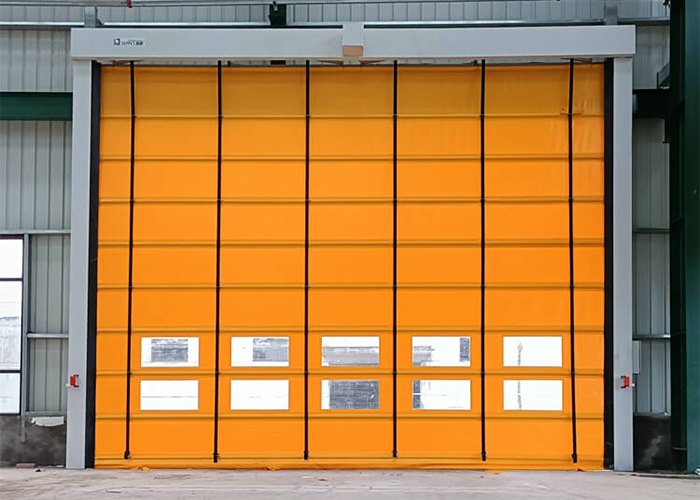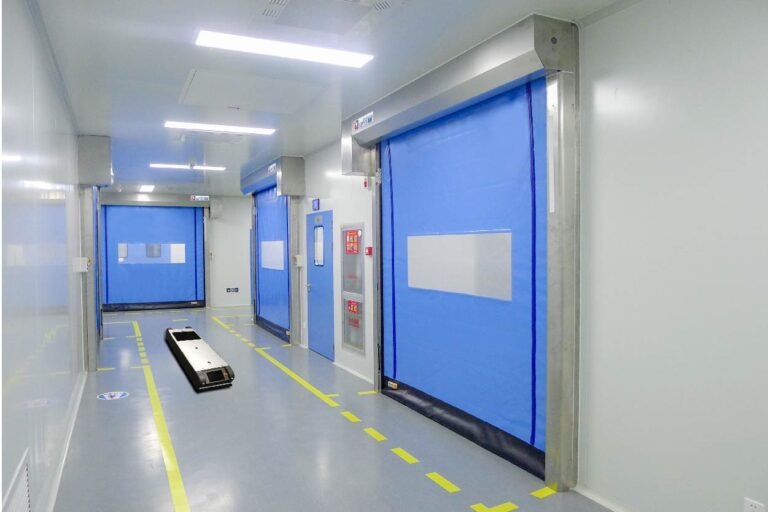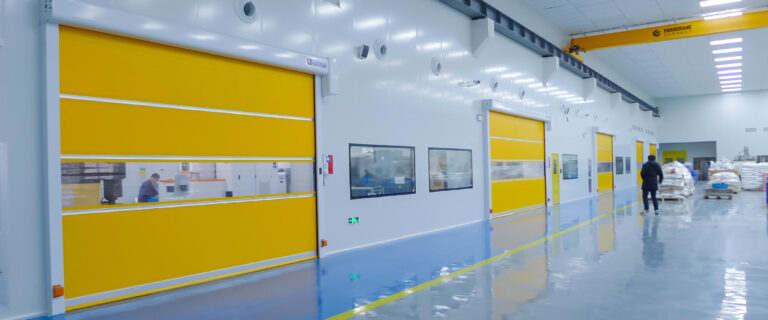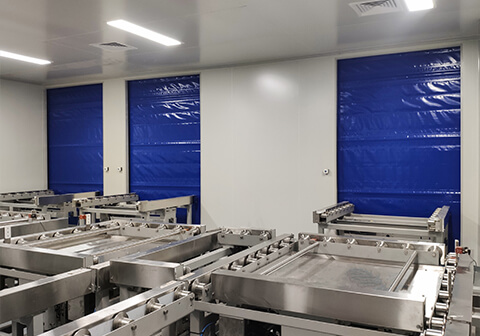Overview: What is a High-Speed Fold-Up Door?
A high-speed fold-up door is an industrial door solution designed to meet the needs of large door openings, high-wind areas, and high-frequency traffic. It combines segmented curtain panels, horizontal wind-resistant bars, and an overhead roll-up structure to maintain high-speed opening and closing while providing excellent wind resistance, dustproofing, and energy efficiency.
Compared to conventional rapid roll-up doors, fold-up doors are more suitable for:
Large logistics channels (height and width ≥4m);
Factory exterior walls and loading/unloading areas;
Port terminals, equipment entry/exit points, and other open areas prone to wind exposure.
Its core advantages lie in structural stability and extended service life, making it particularly suitable for high-frequency access applications in harsh environmental conditions.
Project Background: Configuration Plan for Specialized Accumulation Doors for Outdoor Logistics Entrances
Project Overview
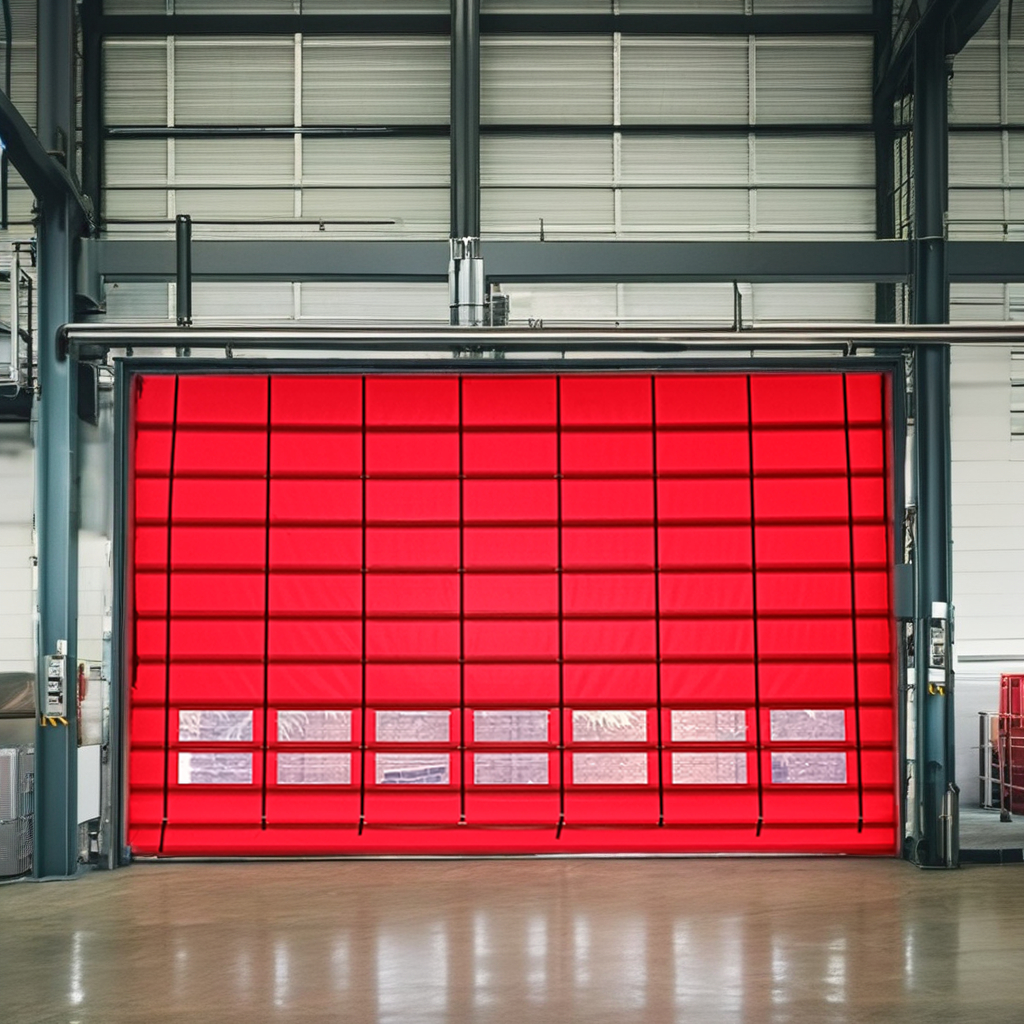
Installation Location: Equipment entrance/exit facing open areas, with significant wind pressure throughout the year
Door Type: High-speed fold-up door
Dimension Requirements: W6500mm × H5000mm
Configuration Requirements
Excellent wind resistance;
Efficient passage response;
Ground-sensing automatic vehicle recognition;
High-frequency opening/closing stability.
Technical Specifications
| Configuration Module | Technical Specifications |
| Door Curtain Structure | Industrial-grade double-layer PVC base fabric (thickness ≥0.9mm), with high-strength horizontal aluminum alloy wind-resistant rods sandwiched between layers. Each section of the curtain fabric can be replaced individually. The curtain fabric features tear-resistant, flame-retardant, and wear-resistant properties. |
| Wind Resistance System | Multiple aluminum alloy wind-resistant rods are installed throughout the full height of the door, running horizontally through the curtain fabric to reinforce the door’s structural rigidity. Maximum wind resistance ≥12 levels, suitable for high-altitude negative pressure zones or outdoor workshops. |
| Drive System | Industrial-grade high-speed winch motor (with variable frequency controller), smooth start-up, precise braking. Typical operating speed: 0.8–1.2 m/s (adjustable). |
| Sensing System | Ground magnetic induction coils installed in the 2.5–4-meter area in front of the door automatically detect vehicles passing through and trigger opening, eliminating the need for manual intervention and improving logistics efficiency. |
| Control Mode | Button + ground sensor dual control, supports PLC remote integration (expandable with barcode scanners/access control systems/safety interlocks). |
| Safety Device | Infrared beam + bottom edge anti-collision safety airbag combination prevents pinching of people or vehicles, automatically detects obstacles during operation, and rebounds. |
| Lifting Method | The door curtain is segmented and stacked at the top, suitable for areas with limited top space or multiple equipment. No large rollers required, with a simple and compact track structure. |
Operational Performance Feedback
After the project was put into use, the door remained stable under prolonged exposure to wind pressure and high-frequency traffic pressure, maintaining the following operational performance:
Smooth opening and closing: After magnetic sensor activation, the average response time is <1 second, with no shaking or misalignment of the door.
Strong wind resistance: Even at wind speeds of 20 m/s, the door curtain operates stably without deformation or warping.
Low maintenance costs: No curtain tears or drive system malfunctions occurred within six months, with extended cleaning and maintenance intervals for the tracks.
Positive employee feedback: Simple operation allows forklift drivers to remain in their vehicles, with automatic recognition and sensing providing significant convenience.
Analysis of the Core Advantages of High-Speed Fold-Up Doors
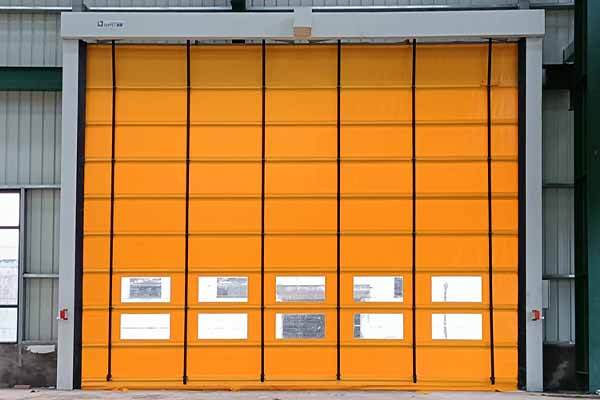
Strong Spatial Adaptability
Traditional roll-up doors require a top-mounted roller, while sliding doors need horizontal tracks. In contrast, stacking doors utilize an upward-stacking design, making them ideal for complex spaces with overhead pipes, cables, and crane tracks.
High-Strength Wind-Resistant Structure
The aluminum alloy wind-resistant rod system provides multi-point support, ensuring the door curtain does not bear direct pressure. This scientific structural design is particularly suitable for port areas, coastal regions, or the exterior walls of large workshops.
Intelligent Sensing Access Control
The geomagnetic control system has a high vehicle recognition rate and stable signal, and is suitable for AGVs, forklifts, and trucks that frequently enter and exit logistics channels, reducing manual control time and improving operational efficiency.
Easy Maintenance, Modular Components
Each section of the curtain, wind rod, guide rail, and electronic control system can be replaced independently, eliminating the need to dismantle the entire system during maintenance and saving downtime.
Typical application scenarios and selection recommendations
| Scenario | Application Purpose | Advantages of Fold Up Doors |
| Outdoor loading and unloading area | Wind and dust protection, quick opening and closing | High wind resistance, fast, safe |
| Connection between warehouse and production area | Frequent traffic, complex roof structure | Small space requirement, quiet operation |
| Port/logistics center | Frequent traffic of large trucks | Efficient magnetic recognition, large door opening, strong adaptability |
| Large equipment workshop | High wind speed environment, restricted area at the top | Strong compression and tensile resistance, simple track structure |
Maintenance Recommendations and Operational Lifespan Management
Under high-frequency use, the operational maintenance of stacking doors directly impacts the overall stability and safety of the passageway. The following recommendations are provided:
Monthly inspection of wind-resistant rods for misalignment or wear, and verification of consistent tension in the curtain;
Quarterly testing of the sensitivity and false-trigger rate of the ground magnetic induction system, with recalibration of control parameters as needed;
The electrical control system should be equipped with overload protection and motor thermal protection functions to prevent continuous operation under high loads.
For curtain contamination, use warm water and a neutral detergent for cleaning, avoiding strong acidic or alkaline corrosive cleaning methods.
The overall structure should be maintained every six months, including lubricating the pulleys and testing the photoelectric protection system.
Comparison of differences in applicability between door types
| Project | Fold Up Door | High Speed Roll-Up Door | 단면 도어 |
| Wind resistance | ⭐⭐⭐⭐⭐ | ⭐⭐ | ⭐⭐⭐⭐ |
| Top space requirements | ⭐⭐⭐⭐ | ⭐⭐⭐⭐ | ⭐ |
| Opening and closing speed | ⭐⭐⭐⭐ | ⭐⭐⭐⭐⭐ | ⭐⭐ |
| Door opening compatibility (large size) | ⭐⭐⭐⭐⭐ | ⭐⭐⭐ | ⭐⭐⭐ |
| Installation complexity | ⭐⭐ | ⭐⭐⭐ | ⭐⭐⭐⭐ |
FAQ
Q1: What is the main difference between a high speed fold-up door and a roller shutter door?
Fold-up doors use a stacking structure, which provides strong wind resistance and is suitable for high doorways and complex outdoor environments, while roller shutter doors are more suitable for indoor partitions.
Q2: Is ground magnetic induction suitable for AGVs?
It is compatible. The sensitivity of the ground magnetic coil can be configured according to the amount of metal in the vehicle and the path, making it suitable for the entry and exit of automated equipment.
Q3: What material options are available for wind-resistant rods?
Users commonly choose aluminum alloy, and they can also select galvanized steel pipes or high-strength composite materials according to wind pressure ratings and door opening dimensions.

